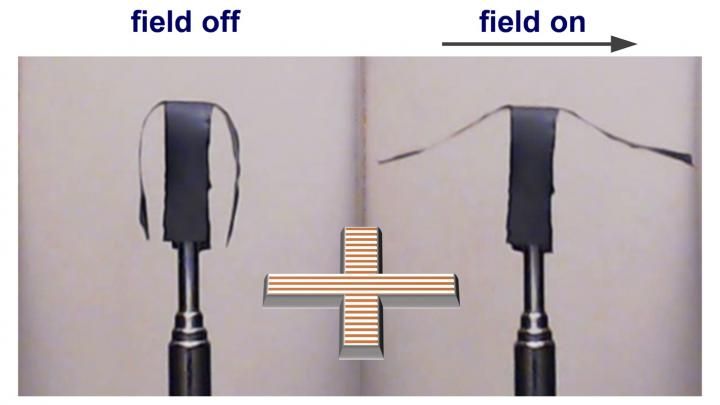Magnetic nanoparticle chains offer new technique for controlling soft robots
esearchers from North Carolina State University have developed a technique for using chains of magnetic nanoparticles to manipulate elastic polymers in three dimensions, which could be used to remotely control new "soft robots."

This image shows a selective actuation of the side arms of a soft robot in a horizontal uniform magnetic field.
Sumeet Mishra, North Carolina State University
The ability to control the motion of soft robots, coupled with their flexibility, gives them potential applications ranging from biomedical technologies to manufacturing processes. Researchers are interested in using magnetic fields to control the movement of these soft robots because it can be done remotely - the control can be exerted without physically connecting to the polymer - and because magnetic fields are easily obtained from permanent magnets and electromagnets.
A team of researchers has now found a way of embedding long chains of nanoscale magnetite particles in sheets of elastic polymer to form a magnetic polymer nanocomposite. By applying a magnetic field, the researchers can control the way the nanocomposite bends - making it a soft robot.
The process begins by dispersing nanoparticles of magnetite - an iron oxide - into a solvent. A polymer is then dissolved into the mixture, which is poured into a mold to form the desired shape. A magnetic field is then applied, causing the magnetite nanoparticles to arrange themselves into parallel chains. The solution is dried, locking the chains into place, and the finished nanocomposite can be cut, to further refine its shape.
"Using this technique, we can create large nanocomposites, in many different shapes, which can be manipulated remotely," says Sumeet Mishra, a Ph.D. student at NC State and lead author of a paper on the work. "The nanoparticle chains give us an enhanced response, and by controlling the strength and direction of the magnetic field, you can control the extent and direction of the movements of soft robots."
The mechanism stems from the structure of the chains. The researchers have also constructed a simple model to explain how the chained nanoparticles affect the mechanical response in magnetic fields.
"The key here is that the nanoparticles in the chains and their magnetic dipoles are arranged head-to-tail, with the positive end of one magnetic nanoparticle lined up with the negative end of the next, all the way down the line," says Joe Tracy, an associate professor of materials science and engineering at NC State and corresponding author of the paper. "At issue is something called magnetic anisotropy, which is caused by assembling the nanoparticles into chains. When a magnetic field is applied in any direction, the chain re-orients itself to become as parallel as possible to the magnetic field, limited only by the constraints of gravity and the elasticity of the polymer."
The researchers believe this technique may be especially attractive for some biomedical applications, as compared to soft robotics that rely on electricity or light for control. "Electrical control can raise safety issues for some medical applications," says Mishra. "And both electrical and light signals pose challenges in terms of communicating those signals to devices embedded in the body. Magnetic fields, on the other hand, pass through easily - and pose fewer safety challenges."
This technique uses inexpensive and widely available materials, and the process is relatively simple and easy to execute, the researchers say.
Original publication
Other news from the department science

Get the chemical industry in your inbox
By submitting this form you agree that LUMITOS AG will send you the newsletter(s) selected above by email. Your data will not be passed on to third parties. Your data will be stored and processed in accordance with our data protection regulations. LUMITOS may contact you by email for the purpose of advertising or market and opinion surveys. You can revoke your consent at any time without giving reasons to LUMITOS AG, Ernst-Augustin-Str. 2, 12489 Berlin, Germany or by e-mail at revoke@lumitos.com with effect for the future. In addition, each email contains a link to unsubscribe from the corresponding newsletter.
Most read news
More news from our other portals
Last viewed contents

Physicists propose a new method for monitoring nuclear waste - Scenarios for using neutrino detectors in nuclear interim storage facilities
Green_infrastructure
Stephen_Hanessian
Redox

The World’s Smallest Impedance Spectroscopy System in the Form of a Pill Finds Weak Spots in Machines and People - Small as a candy: Waterproof IoT sensor reliably measures the properties of liquids even in hard-to-reach places
United_Kingdom_Climate_Change_Programme

E-Series Flow Chemistry system | Flow chemistry systems | Vapourtec
Dirac_large_numbers_hypothesis

IceCube experiment finds Earth can block high-energy particles from nuclear reactions
Nucleophilic_addition





























































